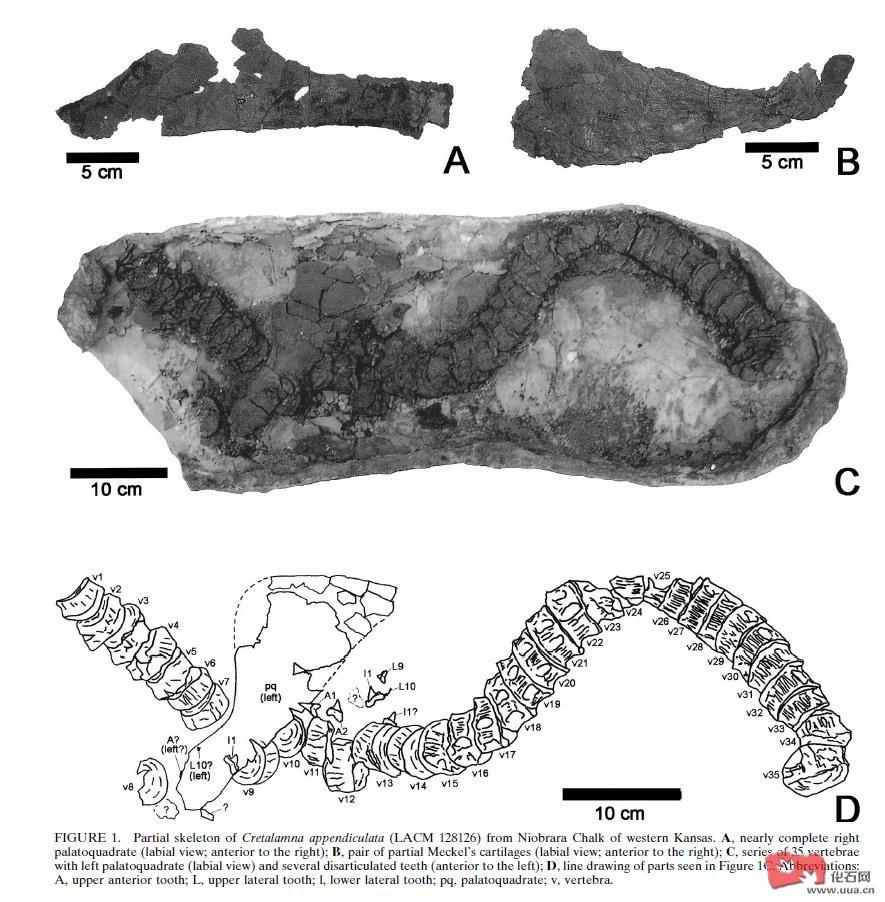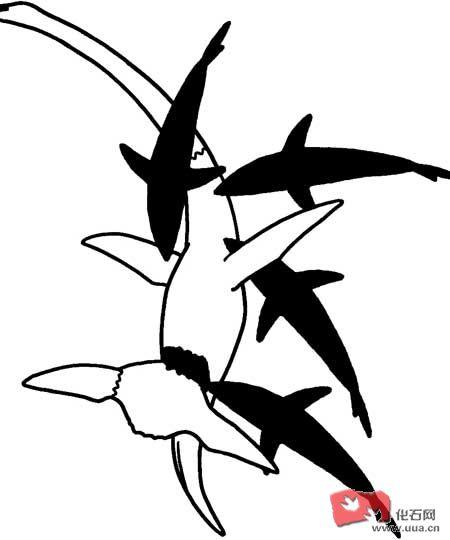


蛇颈龙化石上惊现鲨鱼牙齿 曾遭七头鲨围攻
美国科学家在一具拥有8500万年历史的蛇颈龙骨头化石上发现了鲨鱼的牙齿,经过仔细分析研究后证明,这头巨大的蛇颈龙曾遭到七头 Cretalamna appendiculata(现代大白鲨的早期亲属)鲨鱼的围攻,这一重大研究成果将发表在下周召开的第69届古脊椎动物学年会上。
这具被鲨鱼攻击的蛇颈龙化石从日本中部出土,并被安放在东京的日本自然科学国家博物馆内。美国芝加哥市德保罗大学大学副教授Kenshu Shimada表示:“这是鲨鱼吞噬古脊椎动物的一项无可非议的证据。
Kenshu Shimada和他领导的研究小组发现,五颗Cretalamna appendiculata鲨鱼的牙齿镶嵌在蛇颈龙四块不同的骨头上,同时出土的还有同种鲨鱼的80个相关牙齿。牙齿的大小和形状表明,这些围攻蛇颈龙的鲨鱼都是年轻或者年壮的鲨鱼。
Kenshu Shimada依据出土现场留下的各种材料推测出了8500万年前一场惊心动魄的血腥事件的部分过程:“这头蛇颈龙原本居住在浅海区域,后来由于某种原因死亡了,它的尸体漂浮到深海区域,沉入了海洋的底部并形成了今天的化石。它死亡的情形很可能是这样的:至少有六到七头 Cretalamna appendiculata鲨鱼发现了蛇颈龙,并发起了围捕,吞噬它的肉。但现在还不能确定,这头蛇颈龙是立即被吃掉的,还是在很长一段时间内才被吃掉。蛇颈龙如果真如猜测所言受到了攻击,那么这一来自Cretalamna appendiculata鲨鱼的攻击肯定是致命的,因为蛇颈龙骨头化石上显示,其骨头伤口没有任何痊愈的痕迹。”
Kenshu Shimada自幼喜欢查阅和了解有关蛇颈龙和鲨鱼牙齿的资料,在此期间增长了很多的知识。他说:“我感到很有趣,同时充满自豪,这一30年后的发现赐给了我了解远古鲨鱼的牙齿的机会。”
新墨西哥州自然历史科学博物馆馆长托马斯·威廉姆斯(Thomas Williamson)说:“这不是一件关于鲨鱼吞噬蛇颈龙的普通证据,而是Cretalamna appendiculata鲨鱼吞噬蛇颈龙的证据。真正让人感兴趣的是如此多的Cretalamna appendiculata鲨鱼一起合作攻击或分享蛇颈龙。这种捕食方法和现代鲨鱼猎食很相近。”对于蛇颈龙在遭到攻击后的结果,威廉姆斯馆长表示不能排除蛇颈龙成功逃离围堵的可能。
Cretalamna appendiculata
Sept. 17, 2009 - Remains of a shark-bitten, 85-million-year-old plesiosaur reveal that around seven sharks likely consumed the enormous dinosaur-era marine reptile in a feeding frenzy, leaving some of their shark teeth stuck in the plesiosaur's bones, according to a new study.
The findings, which will be presented at next week's 69th Annual Meeting of the Society of Vertebrate Paleontology, are the first direct evidence of the diet and feeding behavior of Cretalamna appendiculata, a now-extinct early relative of today's great white sharks.
The study, which has also been accepted for publication in the Journal of Vertebrate Paleontology, further represents what lead author Kenshu Shimada describes as "arguably the most spectacular case of shark feeding on a vertebrate carcass reported to date."
Shimada is an associate professor at Chicago's DePaul University and research associate in paleontology at the Sternberg Museum of Natural History. He and colleagues Takanobu Tsuihiji, Tamaki Sato and Yoshikazu Hasegawa analyzed the shark-decimated plesiosaur, Futabasaurus suzukii, which was unearthed in central Japan and then housed at the National Museum of Nature and Science in Tokyo.
They found five C. appendiculata teeth embedded in four different bones of the plesiosaur, and additionally discovered 80 associated teeth of this same shark species with the remains. The size and shape of the teeth indicate they belonged to both juvenile and adult sharks.
Based on the physical evidence, Shimada and his team determined what likely happened to the over 30-foot-long dinosaur-like marine reptile.
"The plesiosaur inhabited the near shore, shallow sea," he told Discovery News. "Whatever the cause of its death, the plesiosaur carcass came to rest belly-side up on the bottom of the sea floor, below the reach of surface waves, where mud mixed with sand grains accumulated relatively rapidly."
"Prior to its decomposition, at least six or seven Cretalamna appendiculata individuals, possibly ranging in size from about 5 to 14 feet in length, began to scavenge the plesiosaur throughout its body. Whether or not the feeding activity took place continuously or intermittently is uncertain."
The researchers also haven't ruled out that the huge marine reptile was attacked and killed by the sharks.
"If the plesiosaur had been attacked by one or more individuals of C. appendiculata, it must have been a fatal attack because bones of the plesiosaur immediately around the embedded teeth do not show any indication of bone healing," the scientists concluded.
Thomas Williamson, curator of paleontology at the New Mexico Museum of Natural History and Science in Albuquerque, told Discovery News that the new paper isn't the first reported evidence of shark feeding on a plesiosaur, but it is "the first evidence of feeding by the shark Cretalamna appendiculata."
"It is interesting that such a large number of individuals of C. appendiculata - six or seven - may have participated in the predation or scavenging," Williamson said, adding that "similar numbers of modern shark species are known to behave this way."
Williamson isn't, however, convinced by the inferred position of the plesiosaur during the feeding, as he said it could have moved during the course of the shark feasting.
Shimada said he grew up reading about the plesiosaur in Japanese children's science books, and vividly remembers seeing photographs of the shark teeth in a pictorial science encyclopedia.
"It's rather amusing - and I'm honored at the same time - that I was given an opportunity to formally describe the very same shark teeth about 30 years later," he said.
To find out more about sharks, visit the Shark Weekend website.
Cretolamna appendiculata普遍被认为是大白鲨 , 长肢灰鲭鲨 , 短肢灰鲭鲨及巨齿鲨等的共同祖先
C. appendiculata 可达3米
The C. appendiculata individual likely measured at least 2.3 m and possibly as large as 3 m in total length. The extant phylogenetic bracket approach indicates that C. appendiculata possessed a dental bulla in each jaw. Cretalamna appendiculata was probably an ecological generalist.
在本文为化石网论坛精华帖,由网友宝源崇德提供,仅供大家学习参考。
编辑:刘琮滢
